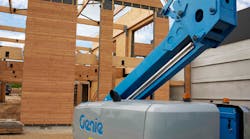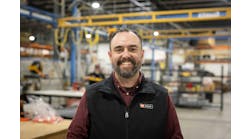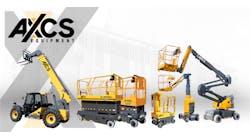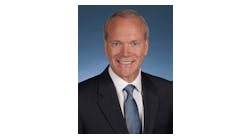Interview with Genie’s Simon Meester: Right Solution at the Right Time
Simon Meester, president, Genie; talks with RER about the drive towards and benefits of electric machines, adapting to supply-chain constraints, expanding the supply base, and more.
RER: What new equipment enhancements or developments has your company come up with in the past year?
Meester: The electrification of our industry is a hot topic right now. We have continued to bring new, exciting hybrid/electric products, which our customers have responded very favorably to.
In May, we announced the industry’s first lightweight telescopic boom in the 60-foot height class. The S-60 DC all-electric boom and the S-60 FE hybrid boom are already available in Europe, the Middle East, Africa, and India, and will be available in North America in 2023. We’re excited about these products because they offer the cleaner, greener performance that our customers and many jobsites are looking for and need. They also perform as well if not better than their diesel counterparts, and they are cost-effective to own and operate.
Then, in August, Terex and Genie announced a Series A investment in Columbus, Ohio-based Acculon Energy, which designs electrification solutions for non-automotive applications. Genie already has demonstrated decades of leadership in electric power in the aerial industry, and this investment in Acculon makes sure we will remain an industry leader in developing quality, next-generation solutions.
And, although I can’t say anything more right now, you can expect more to come from Genie before the year is over.
RER: Any new achievements or developments in safety equipment or accessories?
Meester: One benefit of electrification is that electrifying equipment doesn’t just reduce or eliminate emissions, it also helps reduce and eliminate hydraulic leaks, which can be a headache on jobsites, and costly to clean up. In fact, over the next few years, we expect to see more all-electric solutions that will eliminate leaks completely. We’re not quite there yet, because the solutions aren’t always cost-effective — it has to be the right solution at the right time. But that is the direction we are heading.
Our E-Drive scissor lifts already almost completely eliminate the risk of hydraulic leaks, but one of our other new innovations announced this year, the Lift Tools Spill Guard, is an economical, easy-to-maintain hydraulic containment system that offers additional protection to eliminate the risk of hydraulic leaks.
RER: Obviously longer lead times have been a major concern for rental companies with some saying they are waiting a year or even two years for some machines. What steps are you taking to try to reduce these long lead times?
Meester: This, obviously, has been one of the biggest challenges this year, and last year. Not just for Genie, but for all equipment manufacturers. Unfortunately, there is not one silver-bullet solution; it’s a multitude of different kinds of material categories and often multiple supply tiers deep. Not to mention the logistics and freight challenges. We’ve been deeply engaged with our suppliers to constantly work on solutions and alternatives. We’ve also been working to expand our supply base. And our engineering teams have done a great job of being innovative and, where it’s been possible and made sense, redesigning for the components that are available.
RER: Costs of machines have increased significantly in the recent past? What has led to this cost increase and are you doing anything to try to reduce the cost of new units?
Meester: Like everyone else, we’re facing strong inflationary pressures coming from material cost, freight/logistic constraints, energy cost and disruption in our operations. We have aggressively tightened our own belts to give our customers as much cover as possible but inflation of this magnitude, which we haven’t seen in 40 years, is simply too much to absorb through cost actions alone.
RER: Have you made any improvements that make machines easier to maintain?
Meester: The short answer is: Yes, we have made improvements that make machines easier to maintain and will continue to look for ways to simplify maintenance without sacrificing performance or quality. And electrification itself helps as well, of course, because with fewer moving parts, you’ll have less wear and tear.
The longer answer involves some recent examples of innovations in our boom, scissor lift and telehandler families that simplify maintenance, making it easier and less expensive both in terms of time and money. The design of our S-60 J and S-80 J boom lifts, for example, has been simplified and optimized so that they can deliver the performance and quality our customers expect from Genie with fewer parts that need [to be] serviced, maintained and replaced. Our AC electric drive motors, which you’ll find in our E-Drive scissor lifts, and in many of our DC electric and FE hybrid boom lifts, are brushless and fully sealed, which means they are also maintenance-free.
And finally, we didn’t leave telehandlers out of this equation either. Our GTH-1056 telehandler can come equipped with a 74 hp, DEF-free engine option, which is a low-maintenance solution that also delivers better fuel efficiency than a higher horsepower engine, but with performance similar to a telehandler with a higher horsepower thanks to the transmission gearing.
RER: Are electric machines and/or alternative fuel machines more in demand these days and what is your company doing to address that need in the marketplace?
Meester: More than 70 percent of Genie’s product portfolio is already electrified, which has been a 20-year journey in the making. Genie is not new to this. Technologies that enable electrification, including batteries, are evolving rapidly. We can’t sit still. We need to keep pushing ourselves. The venture with Acculon will help ensure we continue to deliver quality equipment with the right technology for our customers into the future.
Are there any other trends you’re expecting to see in MEWPS in the near future?
Meester: Digitization is certainly another trend in the industry right now. It is certainly playing a key role in helping equipment owners maintain and manage their fleets more efficiently, and it’s also helping take jobsite productivity to the next level. And we’re still just at the surface of what will be possible once we have fully digitized jobsites’ value streams.






